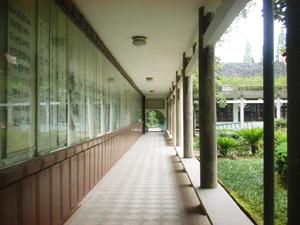Source: CRI
07-16-2007 16:53
 |
Being a special hall for the commemorative activity, Jinggangshan Forces' Meeting Memorial Hall was broken earth in 1977. On May 4th 1980, the building was finished and open to the public. The hall covers the area of 6,789 square meters, of which, there are 3,827 square meters for the construction and 1,827 square meters for the main body. The whole hall is divided into one prefatory room, 5 showrooms and one calligraphic gallery. The exhibits display the history that Mao Zedong led the troops of the Autumn Harvest Uprising to the Luoxiao Mountains and established the base area of Jinggangshan in September 1927, and in April 1928 Zhu De and Chen Yi led the reminder of Nanchang Uprising and Xiangnan peasants' armed forces to Longshi of Ninggang County and met with Mao Zedong's forces to establish the Fourth Red Army, and later the Fifth Red Army led by Peng Dehuai and Teng Daiyuan met with the Fourth Red Army at the Xincheng of Ninggang. Tan Zhenlin wrote the inscription for the Hall.
There are abundant cultural relics in Jingganshang Forces' Meeting Memorial Hall. Except for over 100 exhibits in the showrooms, there are about 50 1-, 2- and 3-level cultural relics and a thousand undefined level pieces in the treasury storehouse. There are more than ten key cultural relics under the state protection, such as the Octagonal Building, the Site of the 1st Party Congress of the Fourth Workers' Peasants' Troops, the Former Residence of the Fourth Red Army Soldiers Committee including the Former Residence of Chen Yi, the Fourth Red Army Hospital at Maoping, the Front Committee of Jinggangshan Party Branch and the Special Committee at the Juncture of Hunan and Jiangxi, the Former Residence of Mao Zedong' and Zhu De's Forces' Meeting including the Officers' Training Unit, Jianjun Square, the Site of Gucheng Meeting, the Site of Bailu Meeting, and two cultural relics under the provincial protection, such as the Fourth Red Army Headquarter at Yangqiaohu and the 1st Division Headquarter of the 1st Workers' Peasants' Armed Force at Yangqiaohu, as well as about 60 cultural relics county-level and below, which are all subordinate to the Jingganshang Forces' Meeting Memorial Hall.
